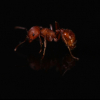Do you think ants can eat solid food?
Edited by Ants4fun, February 28 2016 - 9:17 PM.

Edited by Ants4fun, February 28 2016 - 9:17 PM.
There isn't an easy answer. It's also not one found just by asking what people think, but by scientific analysis. Some species have been shown to more easily consume "solid" foods over others, but ultimately it is the larvae that are the stomach of the colony and the ones responsible for consuming solid foods. We must be careful about overgeneralizing ants, as there are many exceptions to many of the key tenets to the keeping of common, temperate ant species. What we may think are the standards for species that are commonly kept by this forum's predominantly American community, are not necessarily traits that are present in all ants.
Edited by Miles, February 28 2016 - 9:21 PM.
I almost "liked" your answer, Miles, before reading it in full and realizing everything past the second sentence was little more than hollow jibber jabber.
The nutshell of the science is pretty clear that adult ants possess unique anatomical features that effectively filter particles of a certain size. The maximum size of the filtered particles, and the way in which unfiltered particles are used to some nutritive effect, varies considerably by species.
This article goes into great depth of the topic, including particular references to Camponotus:
https://drive.google...sp=docslist_api
Edited by drtrmiller, February 29 2016 - 7:48 AM.
My Pogonomyrmex colony had a single raw sunflower seed that I had been watching for a while and after two days there was a crescent shape missing from the side that was most visited and after 1 week it was almost entirely gone. It was not "misplaced' in pieces in the trash pile since I pick out all trash individually with tweezers. So I do believe that at the very least, this exact species can eat solids slowly. Just to make it clear, there was absolutely no brood at the time that I was observing them.
Edited by Shaye, March 29 2016 - 10:01 PM.
A question that sometimes drives me hazy: am I or are the others crazy?
Of course, ganivores can eat solid food, but they have to chew it very well. It is, like drtrmiller said, the sizw of the particles matters.
![]() Franz
Franz
if you find any mistakes, it's my autocorrection. it doesn't speak english.
Just throwing my two cents of personal observation in. Are there any other topics that cover the interactions and digestion of solids in adult ants? I'm finding a relatively low amount of articles to look through online, and have been testing certain limits of ants (eating of solids is one) as to know different aspects and limits but don't want to physically harm them from lack of foreknowledge.
A question that sometimes drives me hazy: am I or are the others crazy?
My thought is, like other insects reach their adulthood, they lost the ability to eat "solid" food as their mouth pieces has transformed, for example, butterfly, bee, moth, mosquito...
I've also seen this in times when there is brood.
Shaye, I have witnessed my pogonomymex chop up seeds and then give small chunks of seed to the larvae. I believe only larvae eat primarily solid food.
I had touched base on the slow digestion that occurs on a seed in this post
My Pogonomyrmex colony had a single raw sunflower seed that I had been watching for a while and after two days there was a crescent shape missing from the side that was most visited and after 1 week it was almost entirely gone. It was not "misplaced' in pieces in the trash pile since I pick out all trash individually with tweezers. So I do believe that at the very least, this exact species can eat solids slowly. Just to make it clear, there was absolutely no brood at the time that I was observing them.
What I should have said is not that I believe them to be capable to eat solids slowly, but that they could slowly grate or erode it into small enough particles to eat. In that particular occurrence at least.
A question that sometimes drives me hazy: am I or are the others crazy?
0 members, 1 guests, 0 anonymous users